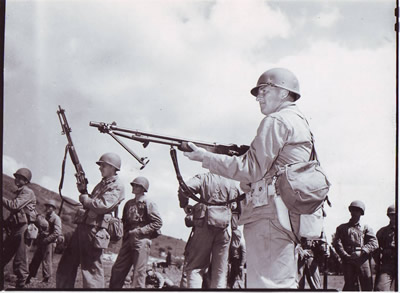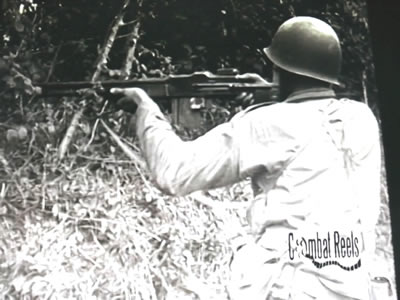Plastic or Wood? W7hich BAR buttstock is correct for WW2?
Author: Alan Winfrey
Editor, Foreword & Commentary: Chris Guska
Date: March 2009
Foreword & Commentary:
Mr Alan Winflrey, a long time US Militaria & Arms collector, was kind enough to provide me with an outstanding, albeit brief piece he wrote examining theoretical usage of BAR buttstock types during WWII. This is not a pure photo study, but a presentation of production numbers and dates referenced which are quite telling. This article draws from multiple books by well respected authors. At times, the numbers and production figures cited by those authors can be conflicting. I believe that Mr Winfrey was able to clearly synthesize those numbers into a cohesive argument. This piece was first published on the WWII Reenactors Proboards forum.
It is difficult to clearly differentiate between plastic and wood buttstocks in combat photographs. One could hypothesize the type of wood buttstock initially supplied on a rifle by examining other components of the rifle. "Modernized 1918a2" rifles built from WW1 production M1918's received numerous upgraded components, not limited to: new type wooden buttstock, new buttplate assembly, new rear sling swivel, new rear sight assembly, trigger housing modified with magazine guides screwed on, modified (cut down) foregrip, new flash hider and bipod assembly. Below is a photo of a typical "Modernized 1918a2"
Editors Notes Continued:
The "Modernized A2" is one of those quirky US Weapons that really only happened for 3 years in US arsenals, but the number of variances in that "type" are tremendous. There are few hard and fast rules when it comes to the Modernized A2. The US was desparately short on BAR's and there was a rush to get them out the door and to the combat area. Although there were prescribed work orders on new parts and modifications to take place, they often did not happen or were done differently.
- Barrels were supposed to be upgraded to the "full profile". Any existing short chamber profile barrels were to be removed and scrapped. This is demonstrably not the case from wartime photos.
- Rear sights were to be upgraded to a windage adjustable milled type - but some non windage adjustable "humped" WW1 rear sights remained in service
- Front foregrips were to be cut down in length and height to expose more of the barrel for increased airflow and cooling. This was not always the case. There are three distinct variations that appear in photos.
- Unmodified
- Cut down in height only
- Cut down in height and length
- Trigger housings were to have magazine guides installed. This is almost universally done on all "Modernized A2's"
- Wood stocks were to be modified or replaced to allow the use of the improved buttplate with shoulder rest.
- Some 1918 style buttstocks were modified for the new buttplate, but the provision for the monopod was not added - thus retaining the enfield style rear swivel.
- The remainder of the buttstocks were new production WOOD stocks - all for the new buttplate assembly and monopod.
- There were NO plastic stocks available to the moderization program until 1943, and early stocks were defective.
- Internal millwork was to be done on the reciever
- Trigger group components were to be upgraded for the Fast/Slow fire
- The Buffer assembly was to be modified for Fast/Slow fire
- The weapon was to be re-finished if needed. Both 100% blued and phosphated examples have been shown in wartime photos. Blued seems to be the most common - with ALL components, including new rear sight, trigger guard wings, and other modified compontents were blued. This flies in the face of traditional "USGI Re-Arsenal" logic of everything being "Parkerized".
Photos Courtesy of Tom Kelly, Source: National Archives and Records Administration
Modernized 1918’s
Ballou states that approximately 60,000 1918’s were available in June of 1940, Canfield states that 188,380 1918’s were modernized into A2’s. The 1918 or modernized 1918 would provide the bulk of the all BAR’s until mid 1943 when new made BAR’s started working thru the supply system in quantity (you must remember the supply system often had a lag time, old stocks would be used up before new items issued). Photos of training in England (41), North Africa and early Pacific you see 1918’s and modernized A2’s, later photos in Italy (43) your see modernized A2’s, training in England (43-44) and from D-Day on in NW Europe you see a mix of modernized and new made A2’s. As Canfield states very few unmodified 1918’s are encountered today and most of those that you do see are British proofed, which makes me think if we had it in inventory it was modernized.
Springfield Armory modernized more than 16,000 1918s.
• In the fiscal report ending June 30th 1940 the armory reports completing 154 units with and additional 7,549 started.
• The 1941 fiscal report shows 8,375 units completed and 31,000 units undergoing modification at the close of the year.
• The 1942 report shows 15,597 units completed and 13,089 undergoing modification.
I am sure some of the units undergoing overhaul are counted in the next years numbers completed so we cant just total up the numbers quoted. My estimate from completed units in 40, 41 & 42 and those in 42 undergoing modification is around 37,215 modified by Springfield alone. In addition to Springfield numerous arsenals and ordnance depots were employed in the rebuild of 1918’s this would account for the number quoted by Canfield.
As for the use of plastic stocks in the modernization process, The plastic stock was approved March 21, 1942. While it was adopted it was not produced in quantity right away. The number of rebuilds drops sharply at Springfield after 42 so we must conclude the modernization program was completed in 42. If IBM was borrowing stocks from Springfield in early 43 why borrow wood if plastic was adopted and available? My guess is that Springfield was still using up stock piles of wooden stocks and rarely used plastic during the war for rebuilds
WWII Production:
New production by years as follows:
International Business Machine (IBM) and New England Small Arms (NESA) - numbers are sum totals of both manufacturers
1943 – 63,065* By mid 1943 (June) only 21,597 BAR's were produced, with the majority of those being delivered in April and May.
1944 – 62,510
1945 – 62,875Editors Note: Early production of BAR's by IBM required the use of wood stocks from the A2 Modernization program due to the unreinforced plastic stocks breaking too easily and subsequent lag in getting the fiber reinforced stocks in production.
Conclusions: Year by Year Breakdown:
So what would be common for each year of the war?
• 1942 would see a mix of 1918’s and 1918A2’s all with wood stocks. At least 188,000 guns.Editors Note: Plastic buttstocks were not available to the modernization process until late 1942 - and then the stocks that were available were easily damaged / defective due to poor design/construction.
• 1943 would see predominantly wood stocked modernized 1918A2’s with a few new IBM, NESA guns making there way to the front later in the year. Of the IBM, NESA guns Only 21,597 units are available by June while almost 9 times as many WW1 production BAR's were in service. Production really picks up and quantities added by month are, July about 30,000, Aug 18,000, Sept 24,000, Oct. 27,000, Nov. 36,000 and Dec. 43,000.
• 1944 would be when you see new made guns with plastic stocks really start hitting the field, these guns would be brought over with the new divisions for the D-day build up.
Editors Note: Modernized A2's still show up in photos throughout the campaign in continental Europe despite the large numbers of newly produced BARs.• 1945 roughly one third of the new production guns were made in 1945 these guns were most likely never saw combat in WW2.
Sources:
Arsenal of Freedom The Springfield Armory 1890 – 1948, Lt. Col. William S. Brophy
Combat Reels, Invasion of Normandy Series, Volume XV, 90th Infantry Division - Tyler Alberts, http://www.combatreels.com
U.S. Infantry Weapons of World War II, Bruce N. Canfield
Rock In A Hard Place, James L. Ballou
Tom Kelly, National Archives and Records Administration
90th IDPG Articles






